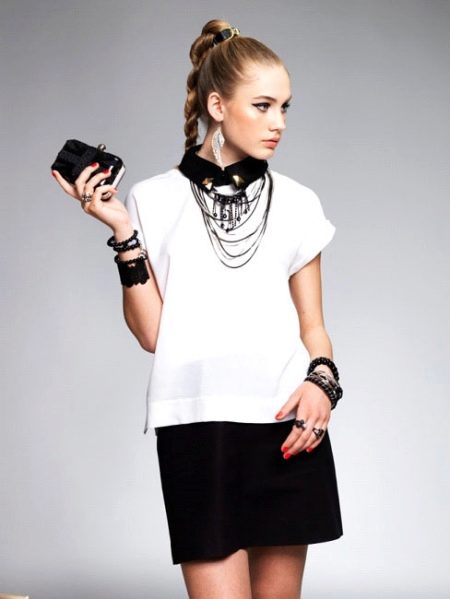A bracelet
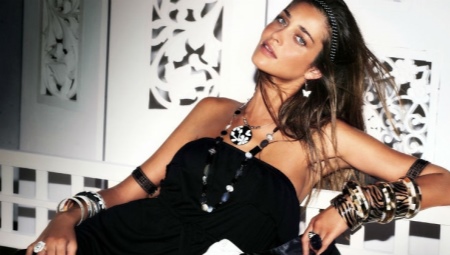
Surely in the arsenal of every woman there are several bracelets, earrings, chains and other jewelry. It is almost impossible to imagine even an everyday and simple bow without them. The bracelet is one of the most feminine and beautiful jewelry. The variety of models allows you to easily choose a worthy accessory for any look. Today, designers offer a wide selection of classic, laconic, strict, extravagant, fantasy and other variations on this theme.

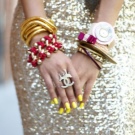



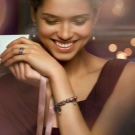
History
The history of this jewelry goes back a huge number of years. Even ancient women of the Paleolithic era had a tendency to self-adornment. This is evidenced by archaeological finds. At that time, the bracelet was nothing more than a stone with a hole.
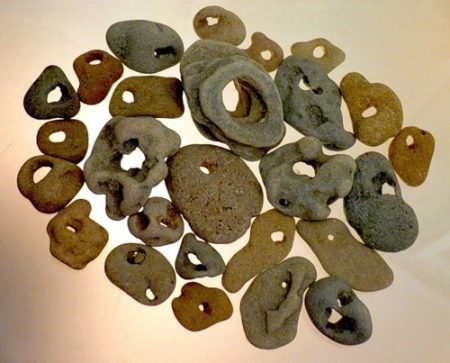
In the Neolithic years, ancient men pulled a strip of leather over their wrists. This reduced the stress on the wrist when throwing the javelin. Now this attribute is widely used in sports disciplines.
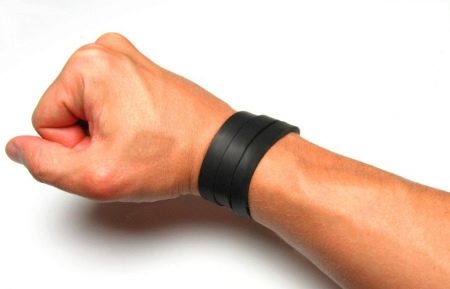
Later, the bracelet was also used as a talisman. It was made from mammoth ivory, wood, stone, or other scrap materials. Ancient people believed that such an object protects a person and his home from evil spirits.
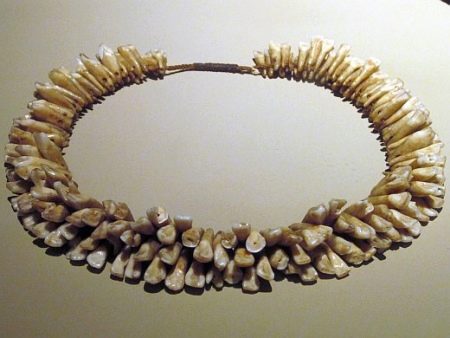
The ancient period of human development gave the bracelet a rebirth. Ancient Greeks, Egyptians, Romans began to actively use the accessory as a decoration. And both male and female. It was made from copper, bronze, and precious metals - gold and silver. It was decorated with various ornaments (lions, leaves, images of divine beings).

The material and appearance of the item could tell a lot about its owner.For example, wealthy and well-to-do people had bracelets made of precious metals and expensive stones. Rulers and priests had the right to wear several bracelets of different widths at once on the wrist and forearm.
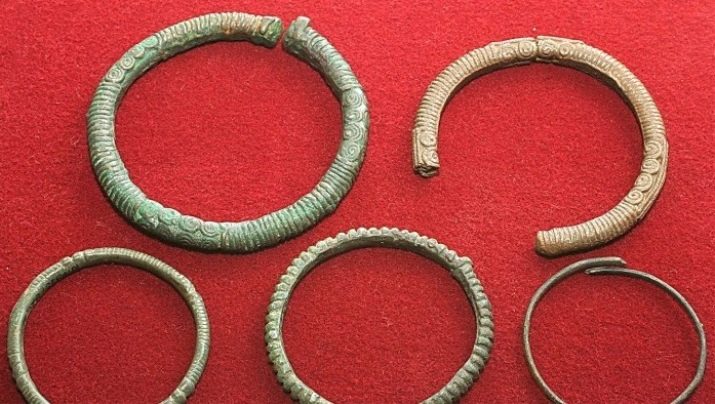
The ancient Egyptians began to use the accessory to decorate not only hands, but also legs. Bracelets for warriors were personalized. The members of the lower classes wore the cheapest pieces, made of fabric or stone.
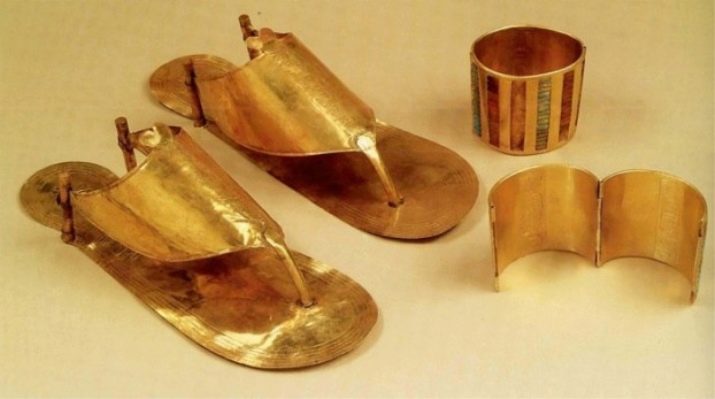
In the Middle Ages, precious metals were used to make accessories. Such adornments were worn by representatives of the nobility. The townspeople adorned themselves with glass bracelets, while the peasants wore copper, leather, or textile accessories. They were worn on the left or right wrist, forearm. One or more bracelets could be worn over clothing or on a bare arm.

In appearance, metal jewelry was divided into several groups:
- by the way of closing (closed, flap or open);
- by type of manufacture (cast or forged);
- by the type of design (wicker, twisted or plate).
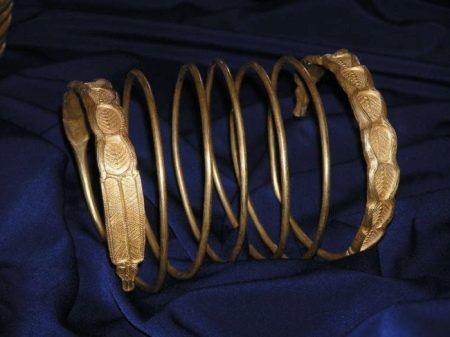
Later specimens were made of enamel and decorated with images of various animals. Then there were chain bracelets that adorned not only the wrists, but also the ankles.
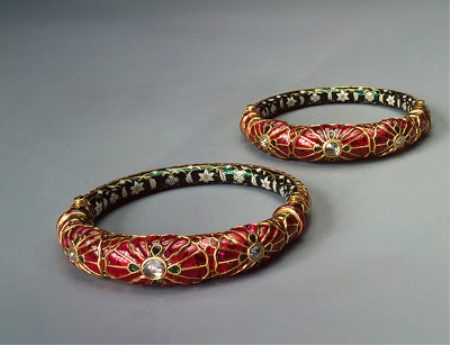
The appearance of the bracelets and their decoration had a certain value. For example, an ornament in the form of a set of certain numbers, letters or other symbols was of a mystical nature.
The 20th century made the range of bracelets even more diverse. New geometric shapes (triangle, rectangle, trapezoid) appeared, plastic, leather, silicone, glass, and fresh flowers began to be used as materials.
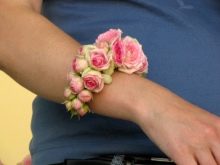
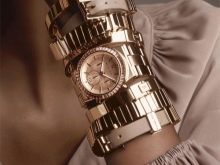
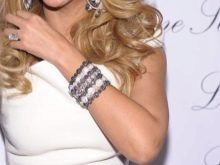
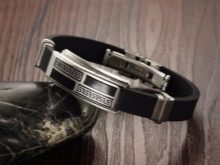

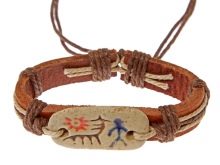
The appearance of the accessories has also undergone a number of changes. Today, an adornment can look like a chain, a ribbon, a structure of several plates, a single piece, and also take other forms.


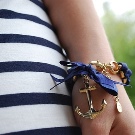
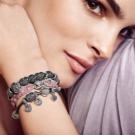
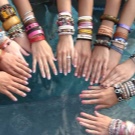
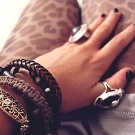
Views and styles
Translated from English, a bracelet means "an ornament intended for an arm or a leg." Worn by women, men and children.

All bracelets are conventionally divided into several groups:
By the type of material used, the decoration can be:
- metal;
- wooden;
- textile;
- leather;
- rubber;
- silicone;
- from natural or artificial flowers;
- plastic;
- glass;
- woven from threads or beads.
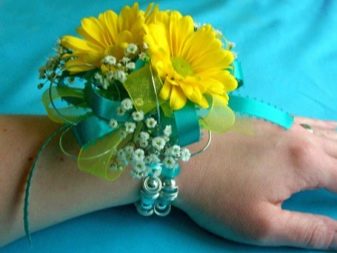
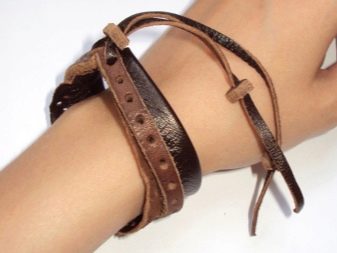
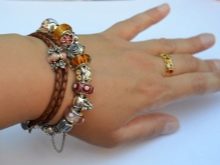
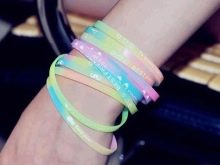
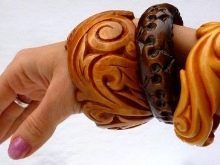
By the type of the locking mechanism:
- open;
- with a zipper;
- with a latch;
- with a hinge mechanism;
- with Velcro.
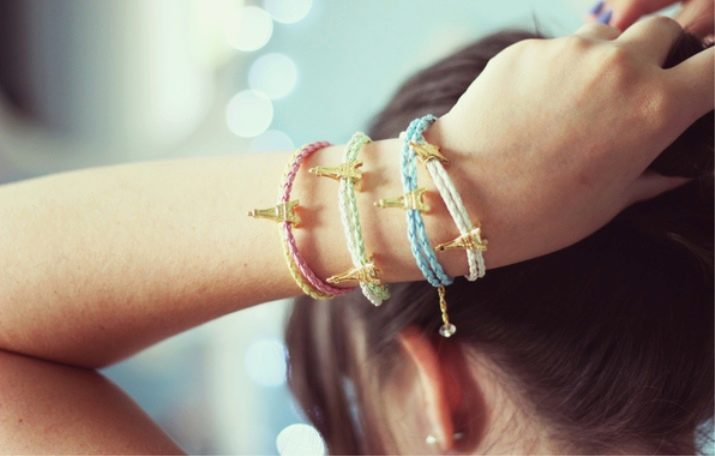
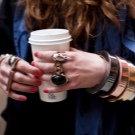
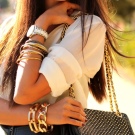
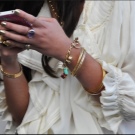
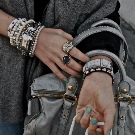
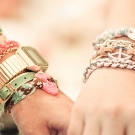
By construction type:
- soft (chain, braided and glider);
- rigid (hinged, spring, closed).
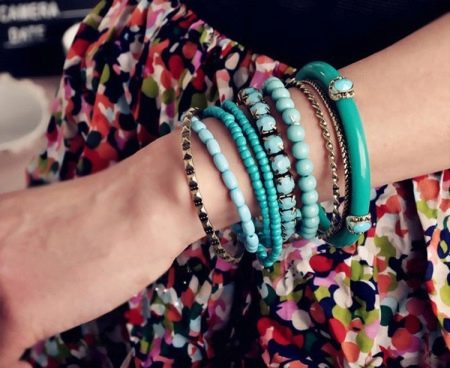
There are several among the most popular models:
- Snake. The adornment has a spiral shape reminiscent of a snake silhouette.
- Mitts. Often woven from beads. The model closes the hand, leaving the fingers free.
- With thorns (most often metal).
- Chain (links of different shapes and lengths are interconnected by various weaving options).
- Watch. Both a decoration and a functional item.
- "Pandora". Jewelry can be designed and assembled on your own using links - charms, which are purchased separately. They can be in the form of animals, hearts, and other interesting figures. They are collected on a chain or cord.
- Tennis bracelet. A graceful, delicate object adorned with stones, most often diamonds.
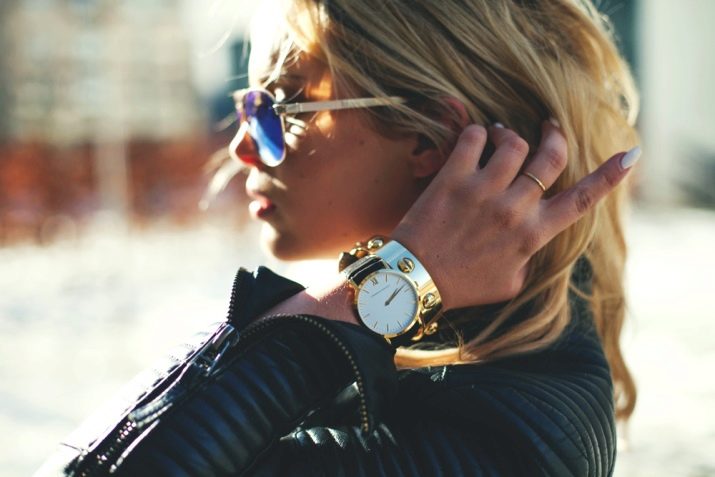
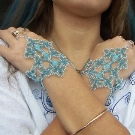

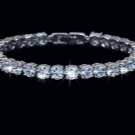

By the type of interweaving of the links, the bracelet can be:
- Armored. The links are unfinished eights lying in the same plane.
- Anchor. The links are located perpendicular to each other.
- Venetian. There is a rectangle in the section of the link.
- Byzantine. An original version of weaving, in which ordinary links are intertwined with twisted eights.
- Royal. The links are in the shape of a crown.
- Rollo. The round links are perpendicular to each other.
- Perlin. The bracelet is made of balls that look like small pearls.
- Bismarck. Two rows of spirally twisted links.
- Double rhombus. The links are in the shape of a rhombus.
- Singapore. Outwardly, such a bracelet looks like a twisted chain.
- Lace. Close-spaced links connected by any kind of classic weave.
- Nonna. The links are located in each other, creating a voluminous, openwork weaving.
- Fox's tail. The links alternate, "creeping" a little on top of each other.

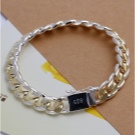
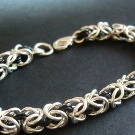
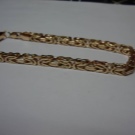
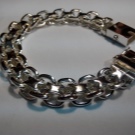

In terms of thickness, bracelets can be thin, wide or of medium thickness.
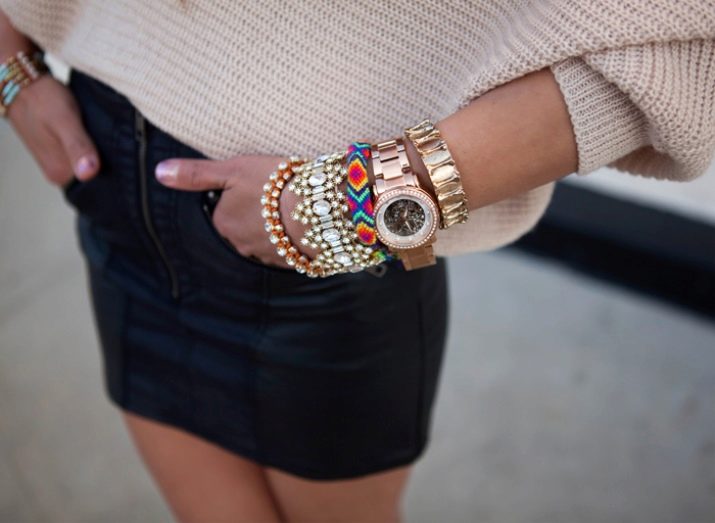
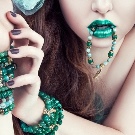

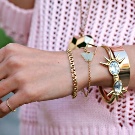
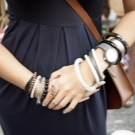
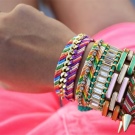
Thin models look good on a fragile, graceful girl. Massive, wide pieces of jewelry are great for everyday life and can be paired with casual clothes. Bracelets of medium thickness are appropriate in a business wardrobe.
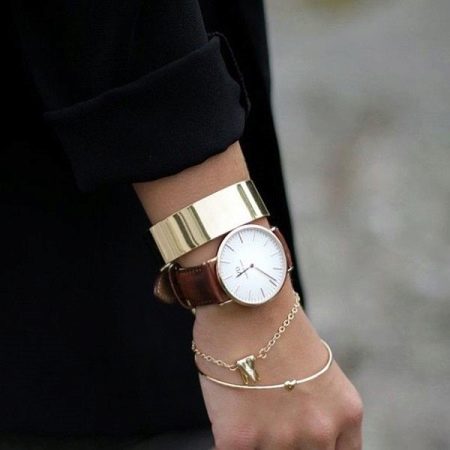
By location. Today, bracelets can be worn not only on the wrist, but also on the ankle and forearm.

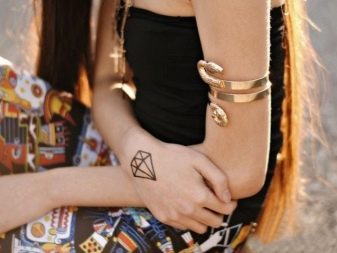
According to the style of performance. In the new season, ethnic models are very popular, as well as pannier bracelets, which are worn simultaneously on the hand and finger and are connected by a chain.
- Boho-style bracelets are bright, original jewelry of an unusual shape, made of textiles, feathers, beads, lace, stones, metal and other materials.
- Oriental accessories look very sophisticated. Lovers of catchy, unusual jewelry can pay attention to models in the Egyptian, Celtic or Slavic style. Egyptian bracelets are made of gold or other metal, but yellow must be present in it. Decorated with ancient Egyptian symbols, figures and other elements.
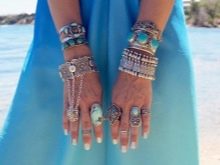
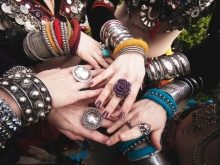
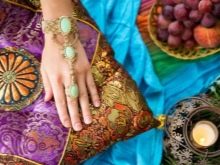
- Vintage jewelry is often decorated with ribbons, precious stones, beads, beads, lace. Such an accessory is easy to make on your own, especially since handmade jewelry is especially appreciated today. Composite bracelets can be made of any material: stones, beads, rhinestones, pendants, plastic or wooden figures.
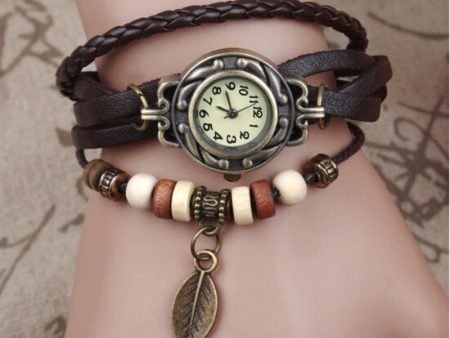
- Bracelets can be more than just jewelry. Jewelry is a great way to make any look brighter and more dynamic and for much more affordable money!
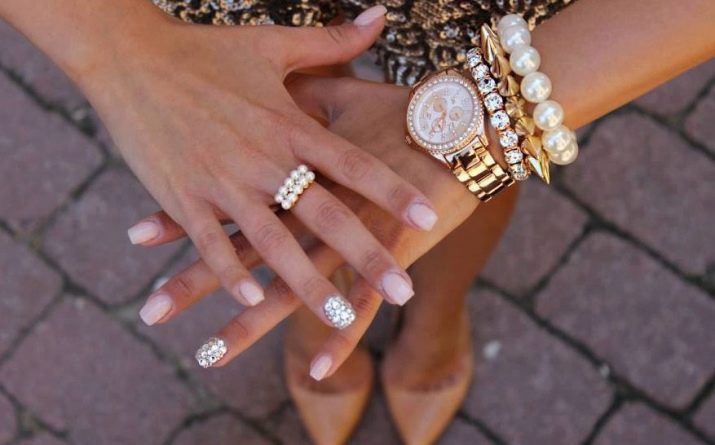

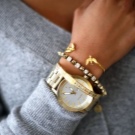
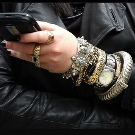
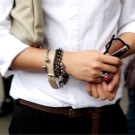

Functions
By their functionality, bracelets are also divided into several large groups:
- Decorative. Jewelry or bijouterie. Serve as a decoration and addition to everyday, business, evening look. Made from all kinds of materials. They are divided into different groups according to design, material, width, presence of decorative elements and other characteristics.
- Cardio bracelets. Usually used for active sports. "Smart" gadgets will allow you to control the pulse and the general condition of the body during cycling, running, power loads.
- Rosary bracelets. At the same time, they are both an ornament of the hand and a spiritual attribute. They are made of different stones, most often they are made sliding to securely fix on the wrist of any width.
- Amulet bracelet. It is worn as a kind of talisman or amulet. It is made of stones, various pendants, threads, metal elements.
- Jewelry with meaning. Such bracelets perform not only a decorative function, but also carry a certain semantic load. For example, metal jewelry with engraving reminiscent of a memorable date. May be supplemented with appropriate inscriptions.
- For nausea for pregnant women. Bracelets can carry not only a spiritual or aesthetic load, they can also provide quite physical assistance, for example, suppress the attacks of nausea in pregnant women. Their principle of action consists in a slight pressure on certain points of the body, as a result of which unpleasant sensations disappear. At the same time, there is no feeling of drowsiness, apathy and other side effects.

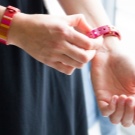

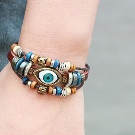

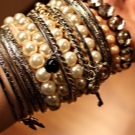
Fashion Models
Among all the abundance of modern jewelry, there are several that will be especially relevant and in demand in the new season.
- Multi-layer or multi-row bracelets. Consist of two, three or more rows. They can be made of beads, glass, charms, figurines from different materials.Options in ethnic, folklore or oriental style look especially interesting.
- With spikes. Most often these are metal spikes on a leather bracelet. This accessory looks very brutal, tough and even aggressive.
- In the form of animals Animal themes have been popular in clothing prints and accessories for many years. It can be cute "baby" bracelets, decorated with bears, kittens, birds. And there may be sharper options: with dragons, scorpions, cobras.
- Braided accessories. A great option to show your imagination and create an exclusive jewelry with your own hands. For example, weave a plait bracelet from strips of leather or textiles and decorate it with hearts or letters. Or create a more original model from strips of paper - an origami bracelet. Or you can buy a wicker jewelry model made of gold or silver.
- With rhinestones. You can do it yourself, but jewelry decorated with sparkling crystals will look more luxurious and sophisticated. These accessories are created for an evening look.
- Original products. When creating such jewelry, the imagination can be truly limitless. Anything that comes to mind or at hand can be used to decorate the product. Among the original products are models with skulls, a cross, colored balls, buttons, pins, dried berries and fruit pits, as well as LED jewelry or even a holographic bracelet. Bracelets with multi-colored enamel, products made of multi-colored elastic bands "angel's heart" look very unusual, and jewelry made using the tatting technique will ideally complement any romantic look.
- Paired jewelry. Bracelets for couples are made of various materials. They can be of different colors, thicknesses, widths, designs, but they must be stylistically intertwined with each other. For example, each accessory can be decorated with a half heart.

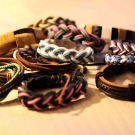
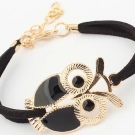
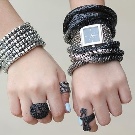
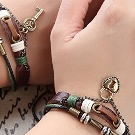
Material
A bracelet can be made from almost everything that is at hand, so the list of materials used is simply incalculable.
- From a thread. It can be a braided piece of jewelry or just a thin thread that ties your wrist.
- Made of tubes (paper or plastic, colored or solid).
- From stones and various minerals. Diamond, pearl, sapphire, ruby, coral, amber bracelets, jewelry made of moonstone, lapis lazuli, turquoise will become a real highlight of any look. Most often, gemstones are framed in gold or silver.
- From fabric. Usually these accessories are made by hand. Bracelets made of soutache, leather, wool, suede are great for everyday wear, for example, under jeans and a top. Lace, satin, silk jewelry will effectively complement any evening dress.
- Made of metal. Such bracelets are not only made of gold, silver or platinum. Metal bracelets made of copper, aluminum, steel, titanium or gold-plated jewelry can look no less impressive. It all depends on the chosen design and the availability of decor.
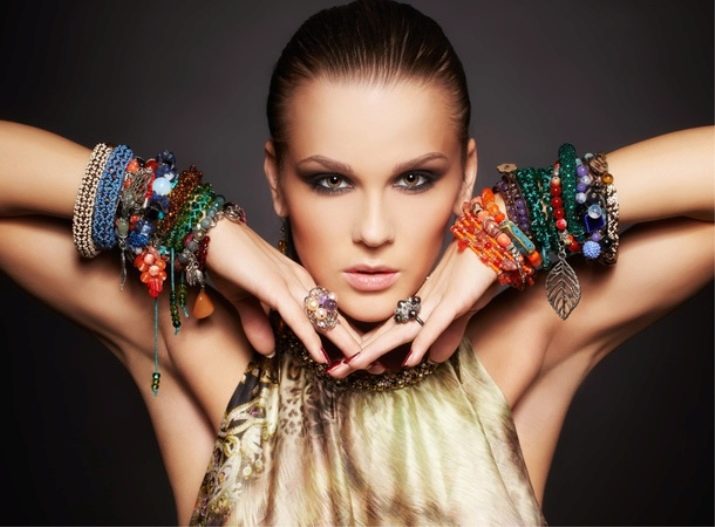
Jewelry is made from even more diverse materials. Here you can find Murano glass, wood, bones, and beads. These are bracelets made of epoxy resin or shells.
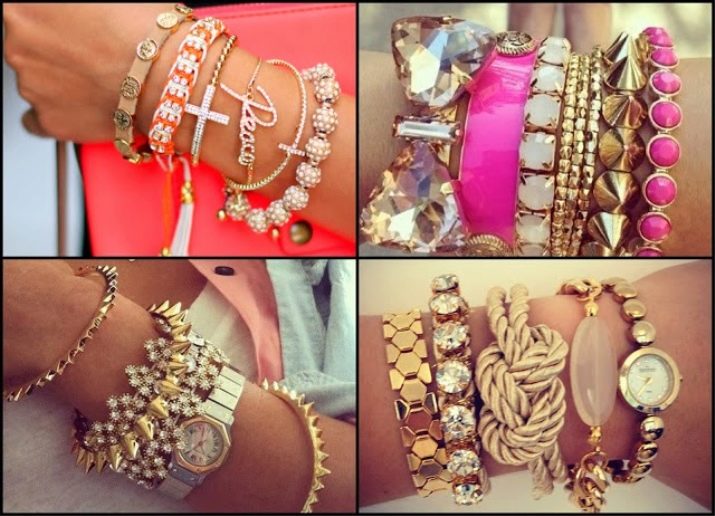
Dimensions (edit)
The best way to measure the width of your wrist is to use tape, a tailor's tape, tape, or thick woolen thread. It is necessary to measure the distance on the part of the arm where you plan to wear the bracelet. The tape should run loosely without pinching the brush. The resulting measurement must be converted to centimeters. If the bracelet will be with large links or loose enough, it is recommended to add another 1-2 centimeters.
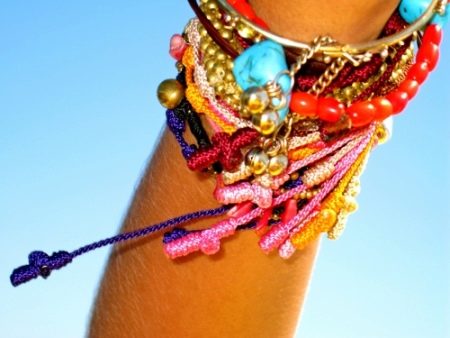
And on the contrary, jewelry with a large stone or on a frame basis should sit tightly on the hand, so there should not be any margin.

This table will show you how to determine the size of jewelry based on the age of a child or the size of an adult's hand. 1inch = 2.54cm.
| Child | Adult | |||||||||||
| Age / Size | 0-6months | 1-1.5 years | 1.5-2 years | 2-3 years | 4-5 years old | 6-7 years old | 8-12 years old | Tiny | Small (S) | Medium (M) | Large (L) | Extra large (XL) |
| Length, inch | 4,5 | 5 | 5,5 | 5,75 | 6 | 6,5 | 7 | 7 | 7,25 | 7,5 | 7,75 | 8 |
Colour
Bracelets, like any other jewelry, are made in a wide range of colors so that you can choose a suitable option for clothes of any shade.

Jewelry that is universal in color looks great with any outfit. First of all, it is a black, white, silver and gold bracelet. If it is complemented by a large colored stone, then its shade should overlap with the color scheme of clothing and other accessories.
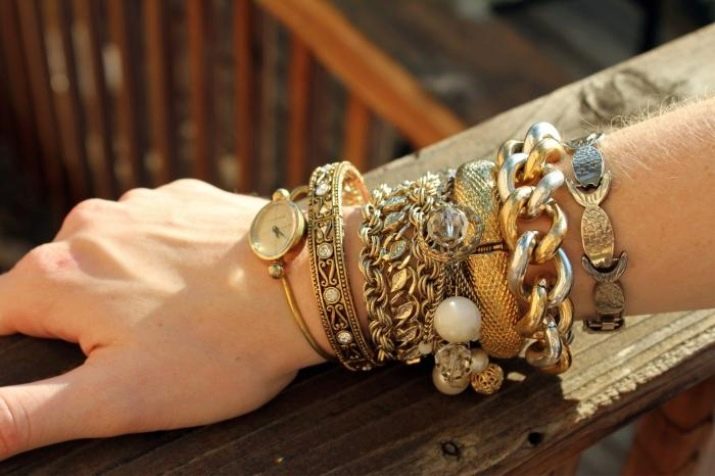
Multi-colored bracelets fit perfectly into a bright summer wardrobe. The main thing here is to take into account the compatibility of different colors. For example, a green bracelet will perfectly set off a purple dress, and a rich pink will look great against a snow-white outfit. A deep blue accessory will work best with clothes of the same bright shade.
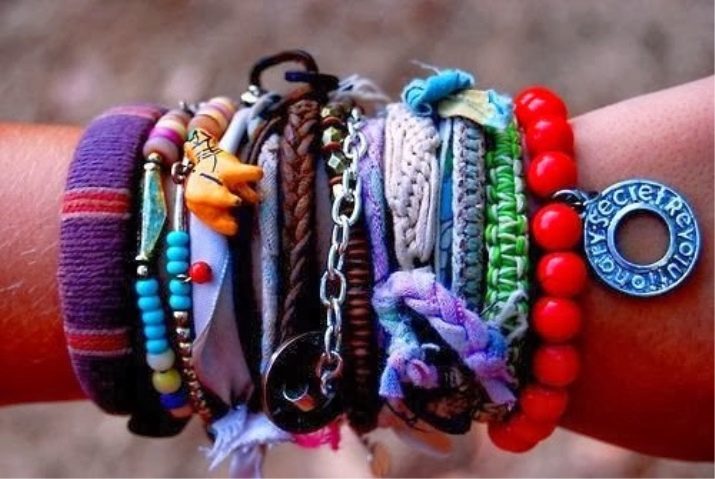
Multi-colored jewelry is very self-sufficient, therefore, it does not tolerate being adjacent to other jewelry. And the ensemble of clothes is best chosen in monochrome colors so that the bracelet does not get lost in bright colors.
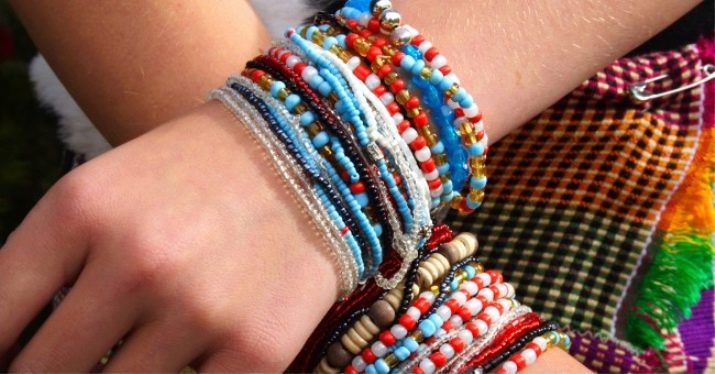
Which hand do women wear?
On the one that is more comfortable at the moment. Right-handers prefer to wear jewelry on their left hand and vice versa. This is due to the issue of convenience, so that the accessory does not cling to or interfere with during operation. However, this rule is very conditional.

If a watch is worn on the left hand, then it is better to decorate the right hand with a bracelet.
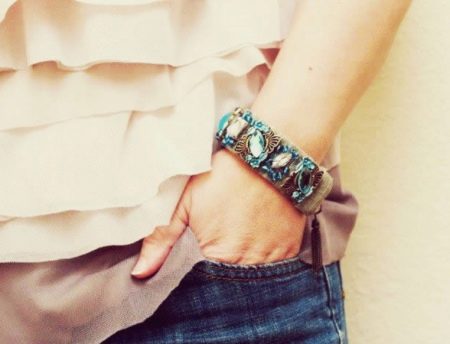
A beautiful, eye-catching accessory for right-handers can be worn on the right hand. She is more involved, so the bracelet will more often be in the field of vision of others.
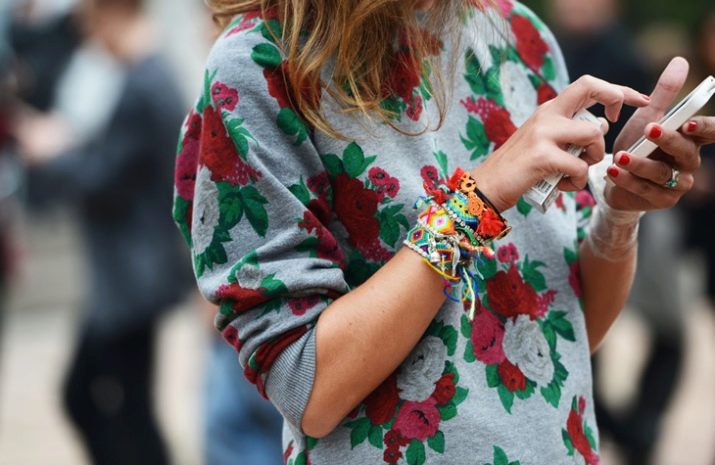
If you have a clutch or a small handbag in your hand, put the bracelet on the same hand. So the image looks more solid and harmonious.
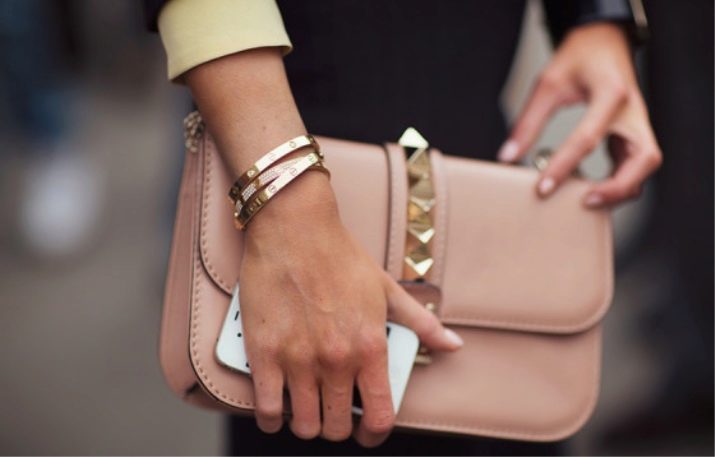
How to fasten?
Fastening the bracelet with one hand is not easy. The clasp can be tricky, and the bracelet will constantly slip off treacherously at the most inopportune moment. A few simple tips will help you quickly and efficiently cope with this task.
- The easiest option is to glue the bracelet to your wrist with a piece of tape so that it does not slip out during fastening.
- Magnetic latch. Some models have this kind of lock. You do not need to fasten it, the magnetic halves will themselves be attracted to each other. However, the mount itself is not very reliable. Other quick-release clasps include hooks, hinges and crutches.
- Fastening with a paper clip. The stationery must be unbent and hook the fastener ring with one hook. Pinch the other end of the paper clip with your fingers. Now you can safely button up the jewelry.
- With a thread. A long thread must be threaded into the ear of the bracelet, then put the jewelry on your hand and pinch the thread with your fingers. Fasten the bracelet and remove the thread.

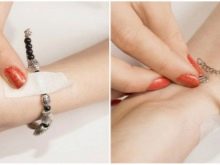

What to wear with?
The bracelet is a versatile and practical adornment. You can wear it every day and wear it under any look. It all depends on its shape, size, color scheme, and the presence of decor.

A thin silver or gold bracelet of a rigid shape or a chain is perfect for any outfit: a formal suit, a light dress, jeans and a T-shirt.
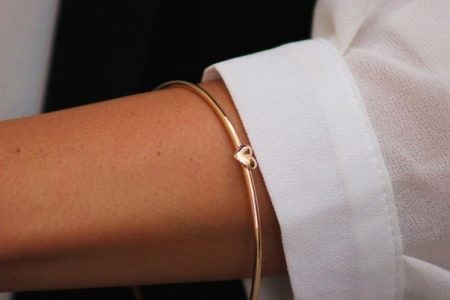
An openwork metal bracelet looks beautiful with a dress - a case or an evening dress.
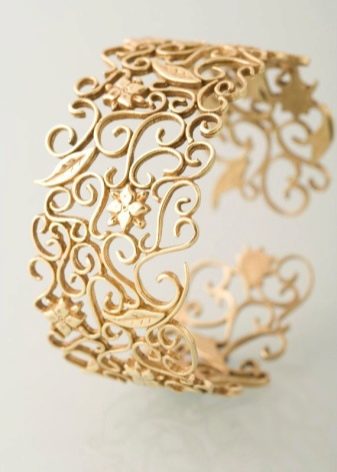
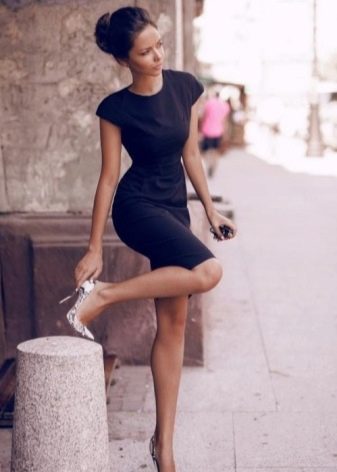
Hand-made jewelry and jewelry are recommended to be worn with casual clothes. It can be casual or romantic.

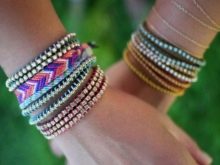
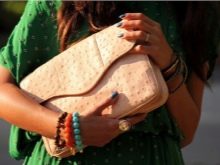
Expensive jewelry, decorated with stones, is worn exclusively on solemn, special occasions with an elegant dress or an elegant trouser suit.
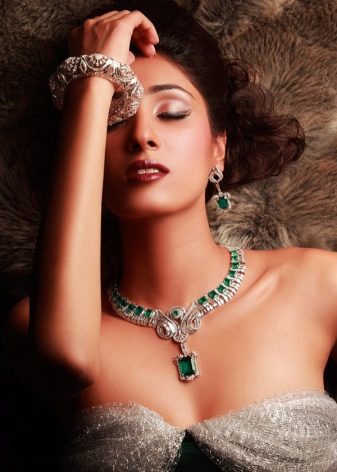
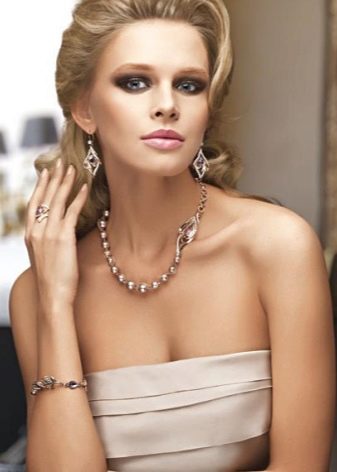
Beautiful images
Several round bracelets of different widths will be a great addition to your everyday look. The lack of graceful forms and decor makes the image more free and youthful.
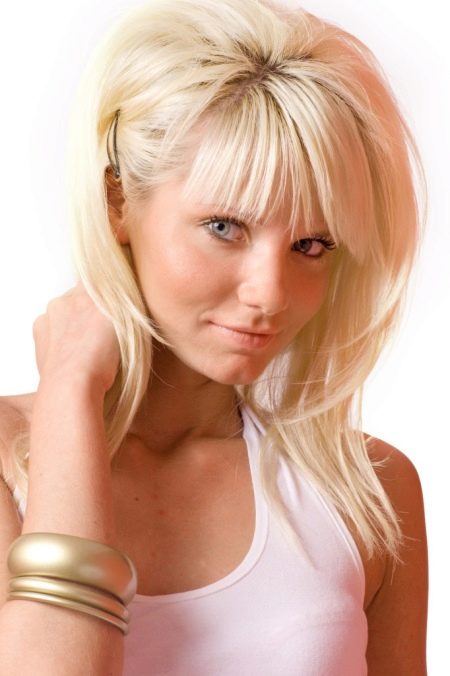
The abundance of jewelry does not always look vulgar and tasteless. For example, for a strict business dress of a white shirt and black skirt, you can put on several bracelets, chains and rings of different shapes at once.The main thing is that they are all designed in a single color scheme, and therefore the image does not look overloaded.
